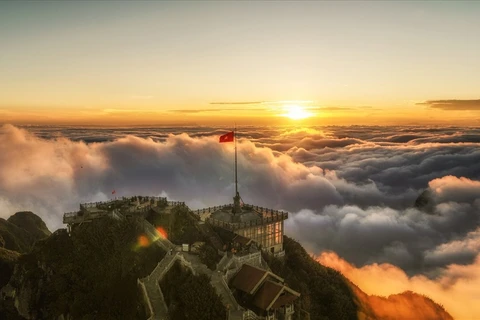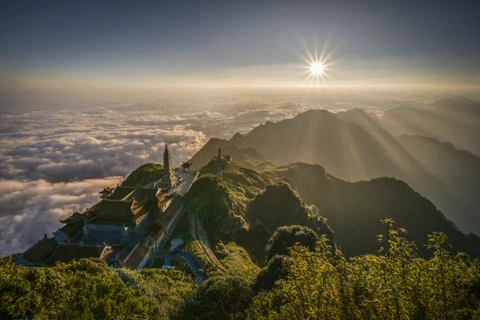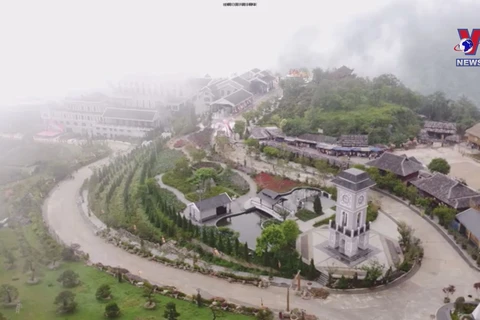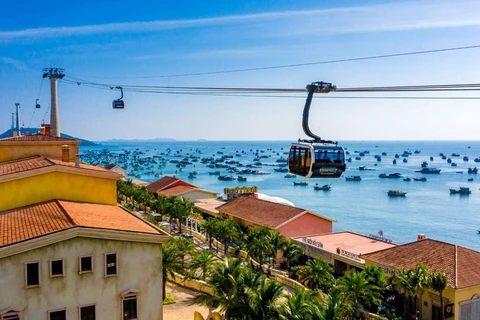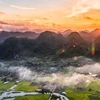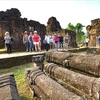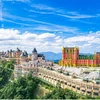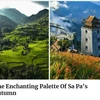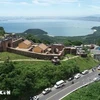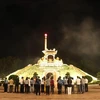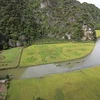Hanoi (VNA) - It is not by chance that among the hundreds of famous mountains in the world, Fansipan of Vietnam has established itself as a muse with flawless beauty in the eyes of photographers, enabling them to take unforgettable pictures.
To photographers, “hunting” beautiful pictures on a mountain is as difficult as conquering that mountain. Many perceive that to be considered a muse of photographers, a mountain needs not only have breathtaking natural landscapes but also be photogenic. For example, Mount Fuji of Japan is viewed as a legend thanks to its perfectly balanced form, or the Matterhorn of Switzerland is snow-capped all year round and boasts an overwhelming scene.
In Asia, Mount Fansipan of Vietnam is one of the endless sources of inspiration for photographers, apart from other majestic and poetic ones like Batur (Indonesia) or Hallasan (the Republic of Korea). Not possessing an impressive form like other mountains in the world, it is attractive thanks to the perfect combination of nature, climate, and imposing structures of worship amidst a vast cloud sea.
As the highest mount in Indochina, Fansipan shows different attractiveness in each season and each point of time. People believe this mountain is a concentration of spiritual energy of Vietnam, so whenever setting foot here, they feel like receiving some power and gaining tranquility in their hearts.
Fansipan also owns a collection of moments that cannot be found anywhere else across the S-shaped country such as the complex of spiritual structures completely blanketed by snow at some points of time, thousands of stars sparkling in the night sky, the cloud sea dyed yellow by sunset light, or clouds flowing like waterfalls down mountain slopes.
“Awakening” photographers
Images of Fansipan can be found easily on the internet at present, but not many know that before 2016, it was almost like an “unawaken paradise” that discouraged photographers when they just thought about climbing it. The difficult access made this mount naturally considered a challenge reserved for only those who are brave and strong and love adventures enough. It took them two - five days navigating forests and sleeping on mountain to reach the peak. To the photographers who used to come to and love Sa Pa, the “roof of Indochina” is like an “unawaken paradise” and a promised land that they were unable to reach.
In 2016, the cable car system invested by Sun Group and built by the world’s most famous producer Doppelmayr Garaventa opened up an opportunity for visitors of all ages to conquer the highest mount in Indochina. The journey which used to last for two - five days is now shortened to 15 - 20 minutes of travelling amidst the cloud sea. To photographers, the chance to “hunt” beautiful pictures of a natural wonder now becomes easier than ever.
It could be said that this “wake-up call’ has provided a surprising springboard for Fansipan. A quick search on the world’s biggest photo storage sites like Getty Images, Shutterstock, and Alamy can help users find surprising numbers of images about Fansipan. They include more than 17,000 on Getty Images compared to over 15,000 about Hallasan - the highest in the Republic of Korea, and over 2,000 about Kirkjufell – a renowned mountain of Iceland. Such figures show that Fansipan has not only turned into a sight to behold in the eyes of photographers in Vietnam or Asia, but also grabbed the interest of international photophiles.
Endless source of inspiration
Standing 3,143m above sea level, Fansipan often isolates itself from the outer world by hiding in the midst of the sea of clouds, creating mysterious beauty beckoning to photographers. Local residents often say Fansipan is the gate to the heaven covered by clouds all year round.
As soon as cable car doors open, visitors can enjoy an awe-inspiring view of land combined with the sky, a sea of floating clouds, and the sunlight more brilliant than any other places in Vietnam. Coming here on a cloudy day, they can feel like the place they have set foot on is half dream half reality or a thing of the past as the structures of worship in the clouds there resembles Vietnamese pagodas in the 15th - 16th centuries.
Photographer Nguyen Minh Tu, who used to luckily admire the sunrise on Fansipan, captured a superreal moment when the fog gradually disappears under the sunlight, which slants through the air and over the metal pinnacle recording the mountain’s height, 3,143m, to create brilliant lines.
Unable to hide his impression of the beauty of the “roof of Indochina”, he said that he and others were speechless in front of the valuable scene. It was much different from the sunrise moments they used to witness, unlike a highland, a sea, or an urban area. Some moments people can capture in photos, but emotions can only be felt by themselves and kept in their hearts.
Not only changing according to points of time in a day, the beauty of Fansipan also varies according to seasons, which is rare in completely tropical regions like Southeast Asia.
In winter, the temperature on Fansipan can drop to minus 9 degrees Celsius, making it one of the few places in Southeast Asia where people can see snow. Sometimes, snow is more than knee deep, creating a stunning landscape similar to that in a fairy tale of a beautiful North European region.
In a picture by photographer Nguyen Manh Cuong, the snow-capped mountain peak reveals its charm with an amazing natural landscape generated by the 60cm-thick snow.
Ancient Rhododendron plants in the snow seem to embrace and protect the temples on Fansipan, creating a both vivid and warm picture in the cold weather of winter in the far-flung area, he said.
The beauty of Fansipan also comes from the imposing spiritual facilities built by Vietnamese people amidst the cloud sea. In 2021, the photo “Buddha statue on the roof of Indochina” by Le Viet Khanh won the third prize in the Professional category of Monochrome Awards. In this photo, the giant Buddha statue surrounded by clouds appears majestic and fantastic, seeming to be an unreal scene.
The giant Amida Buddha statue in the clouds is also an endless source of inspiration for many photographers. The 21.5m-tall bronze statue, located at the highest altitude in the country, was made from tens of thousands of 5mm-thick bronze sheets weighting 62 tonnes in total.
Flowers blooming across the four season and natural landscapes changing every moment give Fansipan different looks in different photos. But it is not hard to realise that varying beauty is based on a common formula which is the harmony of the imposing nature of the mountainous Northwest and the structures showing human’s limitless capabilities. Given this, Fansipan is a beauty of the mountains, rivers, and wisdom of Vietnam that photographers have proudly introduced to the world. Their pictures are also invitations to any foreign travellers who wish to come to see with their own eyes because no pictures can perfectly depict the beauty of this mount./.






